Syrisal 1 Mmol/Ml Oral Solution
\9
Thame Laboratories
\T
Thame Laboratories
Package leaflet: Information for the user
Syrisal lmmol/ml Oral Solution
(sodium chloride)

| I
1. What Syrisal is and what it is used for
v_/

3. How to take Syrisal
Read all of this leaflet carefully before you start taking this medicine because it contains important information for you.
► Keep this leaflet. You may need to read it again.
► If you have any further questions, ask your doctor or pharmacist.
► This medicine has been prescribed for you only. Do not pass it on to others. It may harm them, even if their signs of illness are the same as yours.
► If you get any side effects talk to your doctor or pharmacist. This includes any possible side effects not listed in this leaflet. See section 4.
The name of your medicine is
Syrisal 1mmol/ml Oral Solution but it will
be referred to as Syrisal throughout this
leaflet.
What is in this leaflet:
1. What Syrisal is and what it is used for
2. What you need to know before you take Syrisal
3. How to take Syrisal
4. Possible side effects
5. How to store Syrisal
6. Contents of the pack and other information
Syrisal contains active substance sodium chloride which is a sodium supplement. Sodium chloride is the chemical name for salt. Sodium is an electrolyte that regulates the amount of water in your body. Sodium also plays a part in transmission of nerve impulses and muscle contractions.
Syrisal is used for the treatment and prevention of sodium chloride deficiency.
I |
2. What you need to know before you take Syrisal
v_/
j | Do not take Syrisal:
► if you are allergic to sodium chloride or to any of the other ingredients of this medicine (listed in section 6)
► if you have high sodium levels
► if you have fluid retention (oedema)
► if you have heart disease
► think you have a problem drinking enough water
► if you have a disorder which means you produce more aldosterone hormone than normal
► if you have a condition where the heart needs help to maintain blood circulation
► if you are being treated to produce salt and water loss, usually if you have fluid retention or heart failure or have high blood pressure.
Warnings and precautions
Talk to your doctor or pharmacist before taking Syrisal.
► if you have high blood pressure
► if you have heart failure
► if you have fluid build-up in the lungs or lower limbs
► if you have kidney or liver problems
► if you have pre-eclampsia (high blood pressure during pregnancy)
► if you are on a low-salt diet
► if you have diabetes mellitus
► if you have high levels of fat or protein in the blood stream.
Other medicines and Syrisal
Tell your doctor or pharmacist if you are taking, have recently taken or might take any other medicines. This includes medicines you buy without a prescription, including herbal medicines and dietary supplements. This is because Syrisal can affect the way some other medicines work and some medicines can have an effect on the way Syrisal works.
In particular, tell your doctor if you are taking any of the following:
► lithium
► diuretics (water tablets) such as furosemide and hydrochlorothiazide
► corticosteroids (e.g. prednisone) or corticotrophin. These may make side effects worse
► drugs used to treat high blood pressure (e.g. furosemide, bumetanide, metolazone). May affect the way these drugs work.
Syrisal with food and drink
Syrisal may be taken with or without food.

Pregnancy and breast-feeding
If you are pregnant or breast-feeding, think you may be pregnant or are planning to have a baby, ask your doctor or pharmacist for advice before taking this medicine.
Driving and using machines
Syrisal does not affect the ability to drive or operate machinery.

Syrisal contains:
This product contains lmmol (23mg) sodium per ml. To be taken into consideration by patients on a controlled sodium diet.
This product also contains methyl and propyl parahydroxybenzoate, which may cause allergic reactions (possibly d elayed).
Always take this medicine exactly as your doctor or pharmacist has told you. Check with your doctor or pharmacist if you are not sure.
Doses
Chronic salt depletion Adults: 40ml-80ml (2.4g - 4.8g) daily accompanied by suitable fluid intake at intervals as directed by your healthcare provider.
Use in Children and adolescents: The
healthcare provider will adjust the dose to the individual needs of the child. This medicine can be mixed with breast milk or formula milk for newborn babies.
Kidney Impairment: Dose adjustment may be necessary.
Route and method of administration:
This medicinal product must be taken orally.
Syrisal oral solution may be diluted in a glass of water or baby's bottle.
Use the measuring syringe provided in the pack to deliver the required dose.
Instructions for use of syringe:
► Open the bottle: press the cap and turn it anticlockwise (figure 1). Separate the adaptor from the syringe (figure 2).
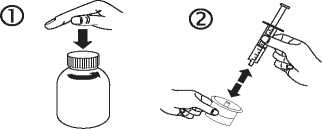
► Insert the adaptor into the bottle neck (figure 3). Ensure it is properly fixed. Take the syringe and put it in the adaptor opening (figure 4).
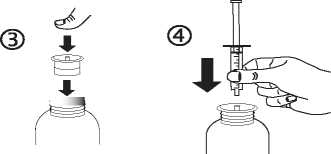
► Turn the bottle upside down. Fill the syringe with a small amount of solution by pulling the piston down (figure 5A), then push the piston upwards in order to remove any possible bubble (figure 5B). Pull the piston down to the graduation mark corresponding to the quantity in millilitres (ml) prescribed by your doctor (figure 5C).
TURN OVER
PIL/UK/MFG012/06/v1
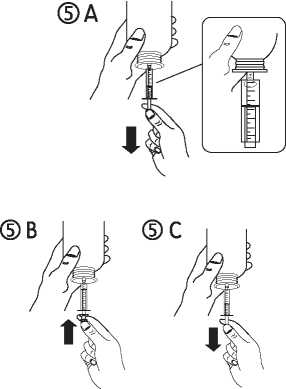
4. Possible side effects
S-N
5. How to store Syrisal
► Turn the bottle the right way up (figure 6A). Remove the syringe from the adaptor (figure 6B).
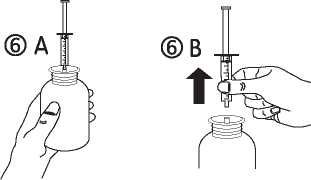
► Empty the contents of the syringe in a glass of water or baby's bottle by pushing the piston to the bottom of the syringe (figure 7). Drink the whole contents of the glass/baby's bottle immediately. Close the bottle with the plastic screw cap. Wash the syringe with water (figure 8).
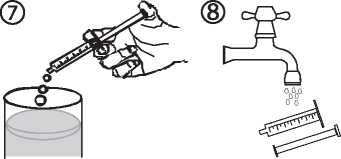
If you take more Syrisal than you should
If you take more Syrisal than you should, tell your doctor or go to your nearest hospital casualty department straight away. Take the medicine pack with you. Overdose may result in restlessness, weakness, thirst, dry mouth and eyes, swollen tongue, flushing of the skin, dizziness, headache, decreased production of urine, high blood pressure, fast heart beat, delirium.
If you forget to take Syrisal
If you forget a dose, take it as soon as you remember. However, if it is nearly time for the next dose, skip the missed dose.
Do not take a double dose to make up for a forgotten dose.
If you have any further questions on the use of this medicine, ask your doctor or pharmacist or nurse.
Like all medicines, this medicine can cause side effects, although not everybody gets them.
Seek medical attention immediately if any of these severe side effects occur:
► severe allergic reactions (rash, hives, difficulty in breathing, tightness in chest, swelling of mouth, face, lips, tongue)
► confusion, weakness
► seizures
► muscle twitching.
Other side effects include:
► nausea
► vomiting
► diarrhoea
► stomach cramps
► thirst
► dry mouth and eyes
► sweating
► fever
► hypotension or hypertension
► excess salt in your blood system
► fast heart beat
► fluid build-up in the lungs or limbs, shortness of breath
► headache
► dizziness, restlessness
► irritability
► coma and death.
If you get any side effects, talk to your doctor or pharmacist or nurse. This includes any possible side effects not listed in this leaflet.
Reporting of side effects
If you get any side effects, talk to your doctor or pharmacist. This includes any possible side effects not listed in this leaflet. You can also report side effects directly via the Yellow Card Scheme at www.mhra.gov.uk/yellowcard.
By reporting side effects you can help provide more information on the safety of this medicine.
► Keep this medicine out of the sight and reach of children.
► This medicinal product does not require any special storage conditions.
► Discard 30 days after first opening.
► Do not use this medicine if you see any visible particles in the solution and contact the manufacturer immediately.
► Do not use this medicine after the expiry date which is stated on the carton and bottle label after 'Exp'. The expiry date refers to last day of that month.
► Do not use this medicine if you notice any signs of deterioration.
► Do not throw away any medicines via waste water or household waste. Ask your pharmacist how to dispose of medicines you no longer use. These measures will help protect the environment.
| |
6. Contents of the pack and
other information
What Syrisal contains
The active substance is sodium chloride.
Each ml of oral solution contains lmmol (58.44mg) sodium chloride.
The other ingredients are glycerol (E422), sodium citrate, methyl parahydroxybenzoate (E218), propyl parahydroxybenzoate (E216) and Purified water.
What Syrisal looks like and contents of the pack
Syrisal is a clear, colourless solution supplied in an amber glass bottle with a child resistant plastic screw cap with a 20ml oral syringe with 1ml graduation mark for measuring and administering the dose and a syringe adaptor.
Syrisal Oral Solution is supplied in bottles containing 100ml and 300ml oral solution.
Not all pack size may be marketed.
Marketing Authorisation Holder and Manufacturer:
Thame Laboratories Unit 4, Bradfield Road,
Ruislip, Middlesex,
HA4 0NU, UK. POM
This leaflet was last revised in 08/2016.
This medicinal product is authorised in the Member States of the EEA under the following names:
UK and IE: Syrisal 1mmol/ml Oral Solution
If this leaflet is hard to see or read, please telephone +44 (0) 208 515 3700 for help.

Thame Laboratories
PIL/UK/MFG012/06/v1